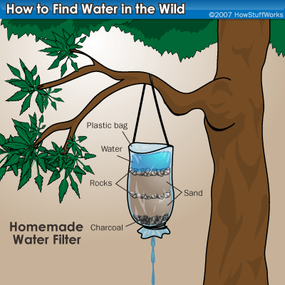Are you someone who enjoys hiking, camping, or any other outdoor activities? If so, then you know the importance of having access to clean and safe drinking water while you’re out in the wild. In this article, we will explore various methods and techniques that you can use to find and purify water in the wild. Whether you’re in a survival situation or simply exploring the great outdoors, knowing how to source and treat water can be a lifesaver.
Finding and purifying water in the wild may seem like a daunting task, but it doesn’t have to be. There are several techniques that can help you locate water sources, such as using your senses to look for signs of water nearby. Once you’ve found a potential water source, you’ll need to know how to purify it to make it safe for consumption. In our article, we will provide you with step-by-step instructions and useful tips on different purification methods, including boiling, using water filters, and chemical treatments. Stay tuned to learn how you can ensure a safe and refreshing water source during your outdoor adventures. When venturing into the wild, one of the most crucial skills you can possess is the ability to find and purify water. Without access to clean and safe water sources, your survival can be severely compromised. In this article, we will explore various methods for finding and purifying water, discuss the importance of water in the wild, highlight the potential dangers of drinking untreated water, provide tips for water storage, and offer insights on navigating water sources at night. So let’s dive in and equip you with the knowledge you need to stay hydrated and safe during your outdoor adventures.
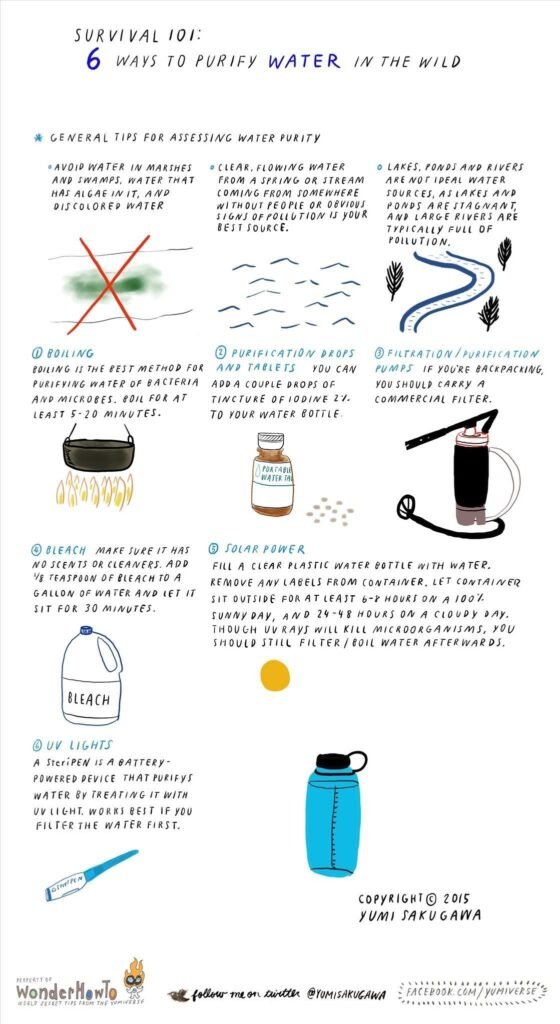
This image is property of img.wonderhowto.com.
Methods for Finding Water
Knowing Where to Look
In the wild, water sources can be scarce and well-hidden. However, there are certain areas where you are more likely to find water. Look for low-lying areas such as valleys or depressions, as water tends to collect in these locations. Additionally, keep an eye out for signs of vegetation, as they thrive near water sources. Rivers, streams, and lakes are obvious water sources, but don’t overlook less conventional options like rock crevices or hollow tree trunks.
Identifying Signs of Water
Even if you can’t visually spot a water source, there are signs that can indicate its presence. Look for animal tracks or paths leading to potential water sources. Birds circling in the sky or coming down to drink can also be a hint that water is nearby. Moreover, the presence of lush and green vegetation in an otherwise dry area may indicate an underground water source. Keep your senses sharp and look for these subtle signs to lead you to water.
Following Animals or Insects
Animals and insects have an innate ability to find water sources. If you come across animal tracks or see animal droppings, follow them as they often lead to watering holes or streams. Be cautious about the size of the animal tracks, as larger tracks may indicate a predator, which may lead you to a larger water source suitable for multiple species. Similarly, insects like bees and ants may lead you to water, as they are attracted to moist areas. Keep a watchful eye and let nature be your guide.
Methods for Purifying Water
Boiling Water
Boiling water is one of the simplest and most effective methods of purifying it. All you need is a fire and a heat-resistant container. Bring the water to a rolling boil for at least five minutes to kill any harmful bacteria, viruses, or parasites that may be present. Allow the water to cool before consuming it. Boiling is a tried-and-true method that should always be your go-to option when purifying water in the wild.
Using Water Purification Tablets
Water purification tablets are lightweight and convenient for outdoor use. They contain chemicals like chlorine or iodine that kill bacteria and other microorganisms, making the water safe to drink. Follow the instructions on the packaging and wait the recommended time before drinking the purified water. Water purification tablets are a great backup option when you don’t have access to a heat source for boiling.
Building a DIY Water Filter
If you don’t have access to purification tablets or the means to boil water, you can create a simple DIY water filter. Start by digging a hole in the ground near a water source and line it with rocks or pebbles. Then, add a layer of charcoal to act as a natural filter. Follow this with a layer of sand or fine gravel. Pour the water through the filter slowly, collecting it in a container. While this method may not eliminate all contaminants, it can still significantly improve the water’s quality in an emergency situation.
Skills and Equipment Needed
Navigation Skills
When searching for water in the wild, navigation skills are vital to help you avoid getting lost or wasting energy. Familiarize yourself with the use of a compass and map before setting out on your adventure. Learn how to identify landmarks and natural features that can serve as waypoints. Navigation skills will not only help you find water, but they will also ensure you can safely return to civilization.
Water Filtration Equipment
Carrying water filtration equipment is essential for long hikes or expeditions. Invest in a high-quality portable water filter that can remove bacteria, protozoa, and sediment from untreated water sources. Look for filters with a small pore size and a high flow rate to ensure effective filtration. Having the right equipment will give you peace of mind knowing that you can reliably purify water whenever needed.
Firestarting Tools
Firestarting tools are a crucial part of your survival kit, as fire provides warmth, light, and the means to purify water. Carry reliable firestarting tools such as waterproof matches, a lighter, or a fire starter rod. Practice building fires in different weather conditions and ensure you have a good understanding of fire safety. With the skills and tools to start a fire, you will have the means to boil water and stay hydrated in the wild.
Importance of Water in the Wild
Hydration and Survival
Water is the most essential element for survival. It is critical for maintaining body functions, regulating body temperature, and promoting overall health. In the wild, dehydration can occur rapidly, leading to fatigue, dizziness, and eventually, organ failure. Adequate hydration is crucial for your survival, so prioritize finding and purifying water when venturing into the outdoors.
Regulating Body Temperature
Water plays a vital role in regulating body temperature. In hot environments, sweating helps cool the body down. However, excessive sweating without replenishing lost fluids can lead to dehydration. By staying hydrated, you can maintain a stable body temperature and avoid overheating in the wild.
Food Preparation
Water is not only needed for drinking, but it is also essential for cooking and preparing food in the wild. Many dehydrated or freeze-dried food options require water to rehydrate them before consumption. Additionally, having sufficient water reserves allows you to cook wild edibles such as plants or fish, providing essential nutrients and increasing your chances of survival.
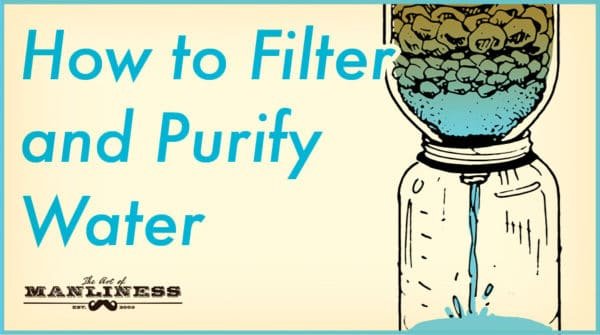
This image is property of content.artofmanliness.com.
Potential Dangers of Drinking Untreated Water
Microorganisms and Diseases
Untreated water sources in the wild can be teeming with harmful microorganisms such as bacteria, viruses, and parasites. Drinking contaminated water can lead to various waterborne diseases like Giardia, cholera, or dysentery. These illnesses can severely impact your health and make survival challenging. It is crucial to purify water properly to eliminate these harmful microorganisms.
Chemical Contaminants
Water sources in the wild may also contain chemical contaminants that can pose health risks. Industrial pollution, agricultural runoff, or natural toxins can contaminate water and make it unsafe for consumption. These contaminants can cause a range of health issues, from gastrointestinal problems to long-term organ damage. Purifying water helps remove or neutralize such chemical contaminants, ensuring your safety.
Parasites
Parasites are another concern when drinking untreated water in the wild. These organisms can enter your body through contaminated water and cause diseases like cryptosporidiosis or fascioliasis. Parasites can compromise your immune system and weaken your body, making it harder for you to navigate and survive in the wild. Proper water purification techniques can prevent parasite infestation and protect your health.
Preparing for Water Storage
Choosing Suitable Containers
When storing water in the wild, choosing the right containers is crucial to maintain water quality and prevent contamination. Opt for food-grade containers made of durable materials like stainless steel or BPA-free plastic. Ensure that the containers have tight-fitting lids to prevent leaks and entry of insects or debris. Capacity-wise, aim for at least one gallon of water per person per day when planning for extended stays in the wild.
Treating Stored Water
Even if you have stored water, it is essential to treat it before consumption, especially if it has been sitting for a while. Rotate your water supply every six months to ensure freshness. If the water appears cloudy or has an off-putting odor, consider filtering or purifying it before drinking. It’s always better to be safe than sorry when it comes to your water supply.
Rotating and Replenishing Supplies
In addition to treating stored water, it is essential to regularly rotate and replenish your water supplies. Water stored for an extended period may develop an unpleasant taste or acquire contaminants. By practicing proper rotation, you ensure access to fresh, clean water that is essential for your survival in the wild.
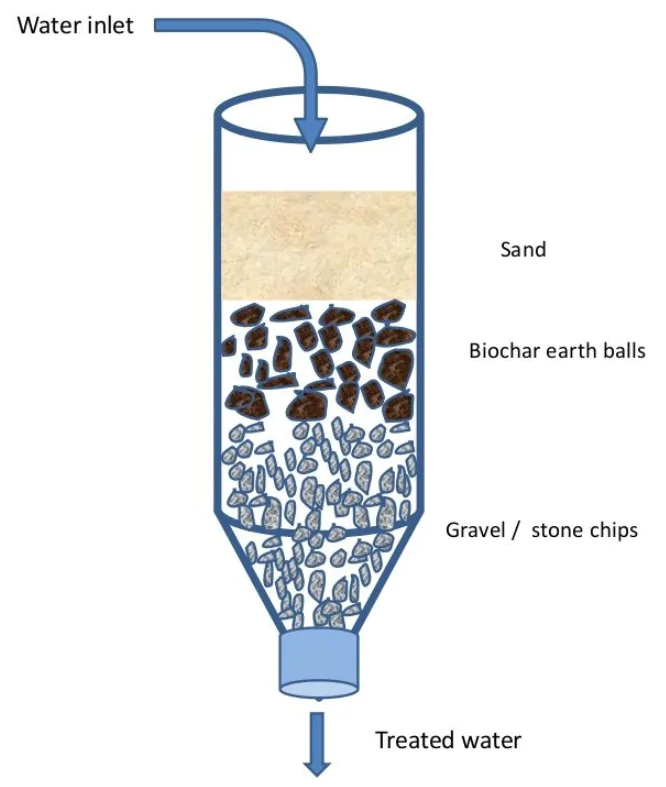
This image is property of www.gowakiwaki.com.
Additional Tips and Tricks
Collecting Water from Plants
Plants can serve as a natural water source in the wild. Look for plants with large leaves or funnel-like formations that may collect rainwater. Tap dew or moisture from leaves by tying a plastic bag around the plant overnight, and collect the condensed water in the morning. While the amount may be small, every drop counts when you are in need of water.
Utilizing Rainwater
Rainwater is one of the purest forms of water available in the wild. Utilize rainwater by setting up a rain catchment system using tarps or ponchos. Collect the rainwater in containers or use it directly for drinking. Remember to remove any leaves or debris from the catchment system before using the water.
Sourcing Water from Natural Springs
Natural springs are an excellent water source in the wild, as the water is usually fresh and clean. Look for signs of a natural spring, such as lush vegetation, a low-lying area, or the sound of running water. Springs can often be found at the base of hills or mountains, where water accumulates and trickles out from the ground. If you find a natural spring, collect water directly from the source or use methods like filtration or boiling to purify it.
Water Safety and Precautions
Testing Water Quality
If you encounter a water source in the wild and have doubts about its safety, it’s crucial to test its quality before consuming it. Testing kits are available that can identify bacteria, parasites, or chemical contaminants in water. If you don’t have access to a testing kit, rely on other purification methods to ensure the water’s safety.
Avoiding Polluted Sources
When finding water in the wild, be cautious of potential pollution sources. Avoid water sources near industrial areas, agricultural fields, or waste disposal sites, as they are more likely to be contaminated. Try to find water sources in remote areas away from human activities to minimize the risk of pollution.
Protecting Water Sources
As responsible outdoor enthusiasts, it is our duty to protect the water sources we rely on. Practice Leave No Trace principles and avoid contaminating water sources with soap, trash, or human waste. These actions can harm the ecosystem and pose risks to your own health. Be mindful of your impact on the environment and leave water sources as pristine as you found them.
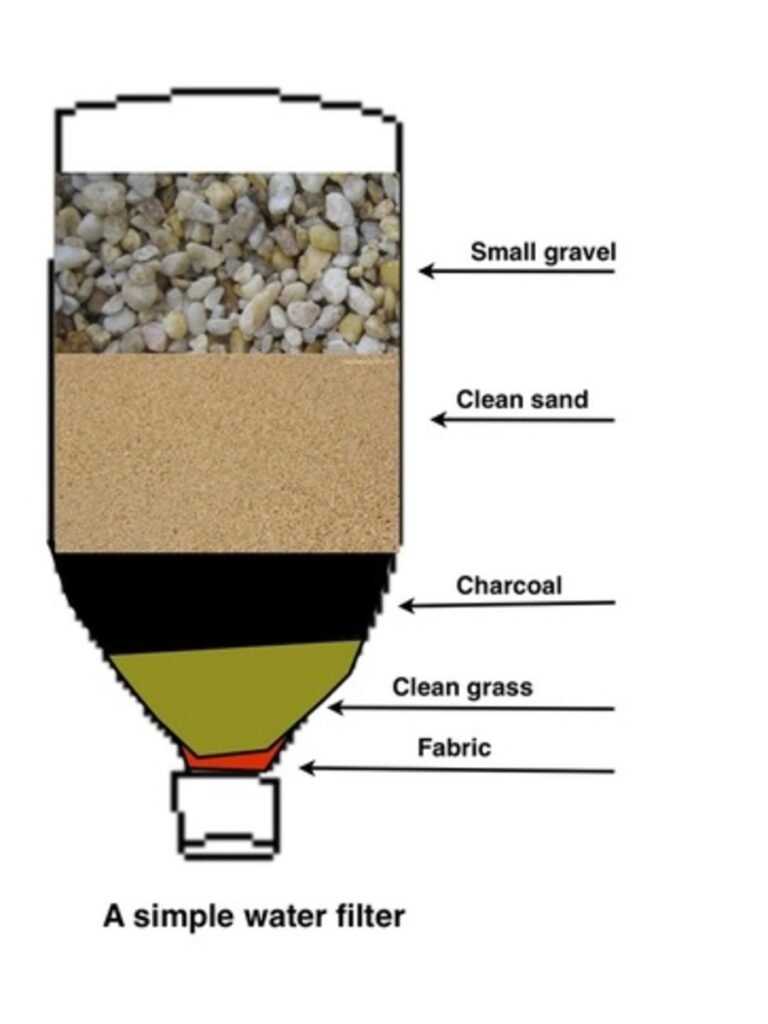
This image is property of images.saymedia-content.com.
Navigating Water Sources at Night
Using Bioluminescent Organisms
In some parts of the world, certain bodies of water are home to bioluminescent organisms that emit light at night. These organisms create a mesmerizing glowing effect in the water. If you spot this phenomenon, it can serve as a natural indicator of water sources, guiding you to potential drinking spots.
Observing Star Patterns
For centuries, travelers and explorers have used stars to navigate their way through the night. By familiarizing yourself with constellations and star patterns, you can determine general directions and locate water sources. Look for stars that are commonly used as navigational reference points, such as Polaris or the North Star.
Identifying Nocturnal Animal Behavior
Pay attention to the behavior of nocturnal animals as they can provide clues about nearby water sources. Animals like bats, owls, or frogs often depend on water for their survival and are more active near water sources during the night. Listen for their calls or observe their flight patterns to find potential water sources in the dark.
Conclusion
In the wild, finding and purifying water is essential for your survival and well-being. By knowing where to look, identifying signs of water, and following animals or insects, you can increase your chances of finding a water source. Purifying water through boiling, using purification tablets, or building a DIY water filter ensures the water is safe to drink. Equipping yourself with navigation skills, water filtration equipment, and firestarting tools will further enhance your ability to find and purify water. Remember the importance of water for hydration, regulating body temperature, and food preparation, while being aware of the potential dangers of drinking untreated water. Prepare for water storage by choosing suitable containers, treating stored water, and regularly replenishing supplies. Utilize additional tips and tricks, such as collecting water from plants, utilizing rainwater, or sourcing water from natural springs, to enhance your water-finding abilities. Practice water safety by testing water quality, avoiding polluted sources, and protecting water sources to maintain their integrity. Finally, use bioluminescent organisms, star patterns, or nocturnal animal behavior to navigate water sources at night. With these skills and knowledge, you can confidently and safely find and purify water in the wild. Stay hydrated, stay safe, and enjoy your outdoor adventures!
This image is property of media.hswstatic.com.

